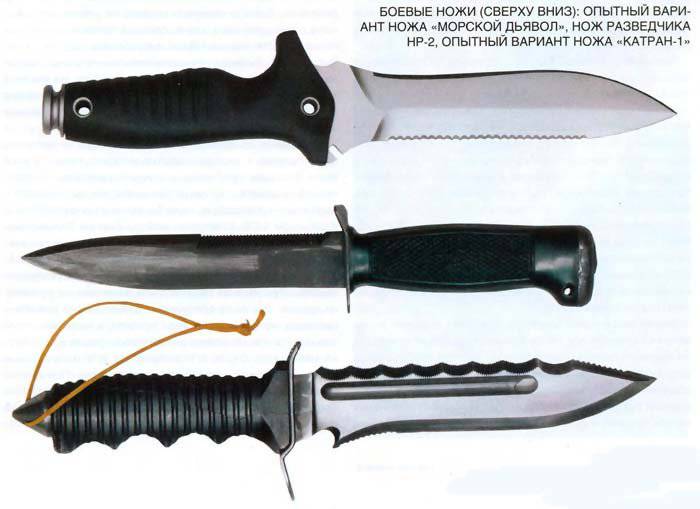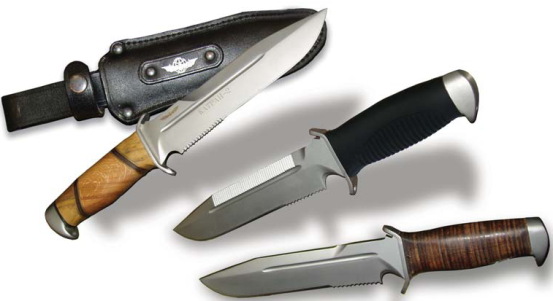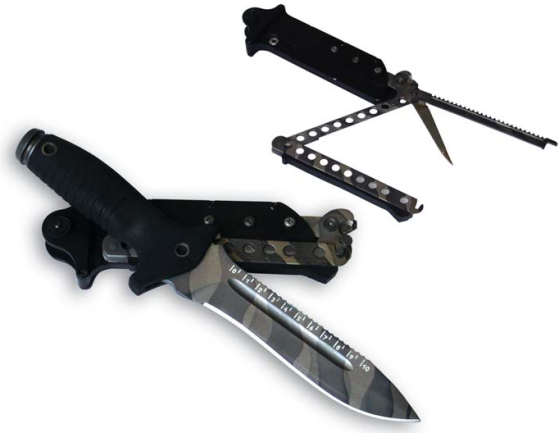"Katran", "Needle" and "Sea Devil", or Knife Detective
A little later, the designer himself took the floor, and a curious thing came to light: Medvedev was not awarded the Qatran himself, but one of its modernized versions. And Skrylev himself learned about the delivery of his offspring to the president only from the press. Here is such an interesting fuss about the knife and its name. But, perhaps, “Katran” and “Sea Devil” are worth more detailed consideration, and not a couple of lines about confusion in the press.

The beginning of the history of these knives refers to the last decade of the last century. Then the leadership of the Russian Navy decided to start a competition to create a new knife, which was supposed to replace the Universal Diving Knife (NVU). By the beginning of the 90's, these weapons were already morally obsolete and required replacement. In addition, the development of NVU did not take into account the fact that it will later be used by the navy divers and combat swimmers. Accordingly, the knife could not do both jobs equally well. There were also problems with the blade alloy. It was corrosion-resistant steel, which was also polished. However, polishing is prone to glare, and the steel used is not very well kept sharpening. In the appendage to this, users have their own claims. For example, the groove for re-stranding the wire, located in the root of the butt, weakened the blade, and the plastic handle tended to slip in the hand with the glove. All this had to be corrected.
The theme of "Cortege" was launched. It envisaged the creation of a knife that combines the qualities of a combat knife, a tool knife and a survival knife. Frankly, not an easy hybrid. A prototype of the knife Pryleva received a blade with a lower butt line, made of a corrosion-resistant steel alloy with a protective anti-reflective coating. On the butt was made file of a specific form - on some "teeth" with a large step were other, smaller. According to the design idea, this allows you to expand the list of materials that are in the teeth of a knife. A hole was made in the blade for joining the scabbard: in this configuration, the swimmer had improvised but reliable and convenient wire cutters. Inside the handle with a corrugated rubber coating is placed a steel case under the NAZ. It is made hermetic, because the knife was created, first of all, as a weapon for the soldiers of the “underwater front”. In addition, the case is one of the strength elements of the design of the whole knife, so that replacing the handle does not present any special problems. The lid of the pencil case was of considerable thickness, which made it possible to use the knife as a hammer. The safety of the knife’s owner’s hand was ensured by a large metal guard. Moreover, all the details of the handle and guard are made in such a way that it is convenient to use the knife with a bare hand and a gloved hand. On some prototypes, the grip cover was plastic, and the case lid was tapered. The latter was supposed to be used as an additional means of impact.
But by the time the prototypes were assembled, fleet not the best of times began. The sailors still needed new weapons, but now they did not have the opportunity to replace the old DDP. Skrylev’s knife could remain in a couple of copies. Fortunately, FSB officers became interested in this product. They expressed their readiness to take a sample of a small batch of knives, but demanded a little change in design. First of all, they needed a “warm” wooden handle. The emergency canister cover was again made flat. The scabbard was finalized: they became leather with a metal liner. Due to its elasticity, the retention of the knife was ensured. The Tula FSB officers were the first to be interested in new weapons and helped establish their production. To begin with, we limited ourselves to a test batch of several dozen copies. It was this development of Skrylev that got the name Katran. The "land" version of the knife was the first to take part in the hostilities, it was in the First Chechen campaign. Katran received many accolades, after which a larger-scale production began. In total, about three thousand such blades were made, although for a number of reasons their exact number cannot be established.
Of those three thousand "Katranov", apparently, a certain amount fell to the craftsmen from one neighboring country. In any case, it is easiest to explain the appearance on the market of knives similar to Katran in appearance, but with far worse characteristics. For example, the author of this article had a chance to see a knife with the inscription “Katran”, whose case (originally sealed) mercilessly let in water, and on its side surface there was a crookedly embossed inscription “Made In China”.
The war ended, and, as a result, the need to order new copies of the Qatran was lost. The knife was removed from production and since then the original model has not been manufactured. However, during the production of the first Katran, several modifications were introduced into production, for example, the classic survival knife. Its main difference from the base model was in the usual file instead of wavy. However, despite the differences, all the knives of the first release in the environment of lovers of cold weapons are often called by the same name: “Katran-1”. Officially, it should be noted, there was no unit in the title. Perhaps the reason for the emergence of the "national" name with a figure was the release of new versions of the knife. The first of these was the "Katran-2". It was much simpler than the first model: they removed the NAZ case, changed the shape of the blade, simplified the guard design, and instead of the protective coating he received matting. Without changes to the "Katran-2" passed except that the "double" wavy file on the butt. Due to the lack of a protective coating on the blade, the new knife could no longer be used in water, although the other characteristics, according to its creators, remained the same or almost the same. Soon appeared and "Katran-3". It differed from the second model with an additional sharpened edge in place of the saw. It was intended for cutting various materials. A little later, the Airborne Forces ordered a number of Katranov-2 with a file similar to that used on standard bayonet knives.

For the civilian market, a special version was released. It was distinguished from the fighting by a slightly sawed tip of the blade, which later began to be manufactured in the form of a screwdriver. There is information that some craftsmen shoved a screwdriver back into the blade. It is clear how the relevant authorities reacted to this. "Katran" was a success not only in the special services of Russia. There is information that one small European country showed interest in the Russian knife. As a result, "Qatran" won the competition from several foreign samples and was purchased for one of the police units. From knives for the “domestic” Russian consumer, they differed in the emblem of the division and the complete absence of references to Russian origin.
At the end of 90-x - the beginning of 2000-s, the fleet again began to show interest in new knives to replace the DDP. This time, the program to create a new weapon was designated by the word “Needle”. As Skrylev recalls, the first versions of the technical specifications were very specific and required connecting at least few compatible things. However, after a series of consultations between the customer and the developers, the finished task began to look more real, although without losing the necessary qualities. The basis of "Needles" took all the same "Katran" of the first version. They changed the design of the scabbard, replaced the wave-shaped saw with the usual one, made the guard part of the handle, and made the shape of the latter asymmetrical: with such a shape, without looking, it is much easier to take the knife correctly. Updated knife tested. And it turned out that it won't work out minor changes.
It was necessary to change almost everything and, first of all, the shape of the blade itself. Butt bevel was quite effective on bayonet knives, which are used along with the machine gun. But for a new combat knife, such a design was considered not very convenient and successful. New blade performed spear-shaped. The penetrating ability of this form was recognized as more effective for underwater operations. We also had to look for a new alloy for the manufacture of the blade: in the technical task it was indicated that the knife must withstand the bending load reaching 100 kilogram. The fact is that during the operation the knife can be used as a lever or even as a support for any kind of load. However, achieving proper strength should not significantly increase the weight. In particular, the first versions of the new blade were not made out, but then they still came to this detail. In addition, the designers of the new knife had to work hard to cover the blade: it should simultaneously protect it and prevent glare. But the knife was intended for use in water, so the usual matting could not be used - during the operation, the structure of the metal surface is disturbed. Because of this, even corrosion-resistant alloys begin to break down under the influence of sea water. I had to go through several options for coverage. Similarly, they did not immediately find the final version of the shape and material of the handle, methods of connecting the parts of a knife, etc.

Not less labor and the creation of the scabbard. For a long time on some knives this accessory is more complicated than the weapon itself. “Needle” was no exception. Its sheaths are based on plastic parts. However, when carrying, they tend to create noise, which required the introduction of an additional fabric cover into the kit. Plastic elements are attached to it, and that, in turn, has parts for the suspension on the fighter's equipment. The sheath has a flat screwdriver and pliers. And in the handle of the last file is placed on the tree and the file on the metal. For use the block with files files leans back and fixed. In earlier versions the scabbard also contained a tool that served as an awl and can opener. In the kit to the knife attached bar for editing. On tests, it turned out that all these tools need to be improved. They changed the design of the saws (now “switching” from one to the other has become much easier), removed the can opener, and the remaining awl received a diamond coating. Thanks to him, there was no need for a separate straightening bar. The final version of the knife, on the tests called the “Sea Devil”, was put into limited operation in some special units of the fleet.

For the Navy combat swimmers, another version of the Devil was made. It differs from the core with a sheath of a simpler design: they lack pliers and files. For divers, rescuers have developed a knife "Killer Whale". It has a tanto blade, which makes it more durable. The same knife is offered as a diving. Also, on the basis of “Sea Devil” they made a knife “Moray”, which is produced in two versions: a survival knife and a diving one. From the original "Moray" differs another blade design, through which it is not a melee weapon. After appropriate improvements, mainly related to the reduction in size, the "Devil" became the "Sapsan". This survival knife is designed for air force pilots. The total length of the Sapsan is slightly smaller than that of the base model, but a harpoon protrusion was added to it. Sapsan sheaths have two suspension options: one safe for descent by parachute, and the second involves carrying a knife on the belt.
Let's return to that knife, which in 2009 was presented to D. Medvedev. As you can see, it could hardly be the "Katran" of the first model. In addition, that knife was developed much earlier than the appearance of the “Needle” program. I. Skrylev asserts that the President was given the knife "Katran-2" in gift decoration. There is no reason not to believe the designer. Nevertheless, publications in the press, in which the image of “Qatran” in some way was mixed with “Sea Devil”, did their job. Soon after those commemorative exercises in the Baltic, the firm NOKS, where Skrylev works, was forced together with the Zlatoust firm AiR to start production of the gift version of the Devil. Of course, this is not the “Katran-2”, which was handed to Medvedev, but sales of the new gift knife are said to be going well. He became a prestigious and original gift.

Information